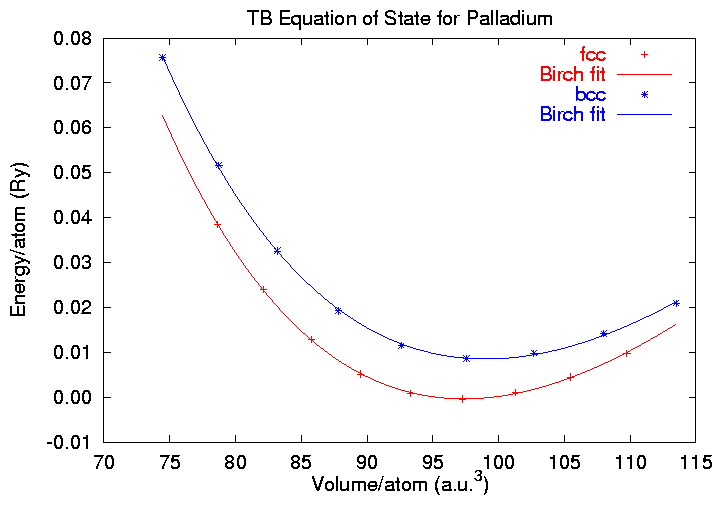Last updated -- 17 December 1999
This page shows how to interpret the results of a run of the static Tight-Binding program.
To run the code you will need several files:
The first setup page has the information you need to find the first three files. The second setup page details the construction of the SKIN file.
$ls -l
total 47
-rw-r--r-- 2 mike mike 11634 May 25 11:21 SKIN
-r--r--r-- 2 mike mike 2410 Jun 2 1995 bcc.08
-r--r--r-- 2 mike mike 3468 Jun 1 1995 fcc.08
-r--r--r-- 2 mike mike 7162 May 25 11:00 pd_par
-r--r--r-- 2 mike mike 10003 Aug 15 1996 spcgrp.bcc
-r--r--r-- 2 mike mike 10003 Jul 28 1997 spcgrp.fcc
The static program reads the SKIN, parameter, k-point and space group files and produces three types of output:
The SKENG file should look like this (I've edited out some of the spaces for clarity):
fcc 6.80 78.608000 .256797277 .038518611 .004624940 fcc 6.90 82.127250 .242276268 .024020018 .003607059 fcc 7.00 85.750000 .228826554 .012851841 .002567833 fcc 7.10 89.477750 .216099374 .005144880 .001585545 fcc 7.20 93.312000 .203907640 .000802042 .000703127 fcc 7.30 97.254250 .192381931 -.000433135 -.000048809 fcc 7.40 101.306000 .181915501 .001011535 -.000625782 fcc 7.50 105.468750 .172358630 .004490358 -.001055989 fcc 7.60 109.744000 .163145676 .009793201 -.001410457 bcc 5.30 74.438500 .260259224 .075705141 .006146868 bcc 5.40 78.732000 .242412877 .051649155 .004989744 bcc 5.50 83.187500 .225463671 .032543604 .003583378 bcc 5.60 87.808000 .209785142 .019214376 .002215440 bcc 5.70 92.596500 .195912039 .011547488 .001040896 bcc 5.80 97.556000 .184151847 .008633127 .000166792 bcc 5.90 102.689500 .173251125 .009740659 -.000557775 bcc 6.00 108.000000 .163646043 .014154297 -.001067757 bcc 6.10 113.490500 .155520444 .020906271 -.001364898
An easy way to visualize these results uses the free program gnuplot. If we use the 3.7 version, we can even use its fitting routines to make a Birch fit to the fcc and bcc data, which will allow us to obtain the equilibrium lattice constants and bulk moduli for the two phases. Using the gnuplot script pdfit.gnu we get the output
$ gnuplot pdfit.gnu [Fitting routine information deleted, see fit.log] Results of 3rd order Birch fit: FCC Lattice: E_0 = -0.000386492440903136 Ry V_0 = 97.3474098780412 Bohr**3 a_0 = 7.30233014694192 Bohr B_0 = 231.411489521339 GPa B_0'= 3.55235088090646 BCC Lattice: E_0 = 0.00848554898771665 Ry V_0 = 99.0135973207143 Bohr**3 a_0 = 5.82874351166457 Bohr B_0 = 217.013641667665 GPa B_0'= 3.39317618244097 FCC - BCC energy diference = 0.120710317208493 eVUsing the GIF driver available with gnuplot, we produce the following result:

Return to the first setup page
Go back to the second setup page
Look at other examples.
Return to the static Reference Manual.